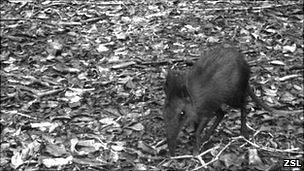Camera spots 'new species' of elephant shrew
- Published

A mystery animal with a long snout has been spotted in Africa, which scientists say could be a completely new species of giant elephant shrew.
Camera traps set up along the coast of north-eastern Kenya captured pictures of the elusive mammal.
Scientists say the find underlines the conservation significance of isolated African forests, threatened by rapid coastal development.
The animal was first seen by a fellow of the Zoological Society of London.
She was unable to identify the creature, which prompted the ZSL and the Kenya Wildlife Service (KWS) to set camera traps in the area.
'Captivating animals'
Scientists say that there is still much to learn about the sengi, an elusive creature only found in Africa.
It uses its long, flexible snout to scoop up insects. The animal first appeared in Africa more than 100 million years ago and, despite its common name. is not related to shrews.
But despite being small and furry, it does share a common ancestor with elephants, as well as with sea cows.
Until this latest discovery, there were only 17 known species of sengi, split into two groups: the giant sengi and the smaller, soft-furred sengi.
"With their ancient and often misunderstood ancestry, their monogamous mating strategies, and their charismatic flexible snouts, they are captivating animals," said Galen Rathbun from the California Academy of Sciences.
"It is always exciting to describe a new species - a necessary precursor for ensuring that the animals are protected," she added.
The next step for conservationists is now to confirm that the mammal is indeed a new species of sengi.
This can be done by means of genetic analysis once DNA samples of the tiny creature have been collected.
ZSL senior field conservation biologist Rajan Amin said that besides being an exciting discovery, the finding also highlighted the conservation importance of the "unique coastal forests" of north-eastern Kenya.
His colleague, Sam Andanje from KWS, agreed, adding that previously, the biodiversity of the area was poorly understood because of limited access as a result of security problems and poor infrastructure.
Now the region is also under threat from on-going coastal developments, he added, and the remote forests need more protection than ever.
- Published1 February 2008
- Published29 April 2008
- Published16 September 2010